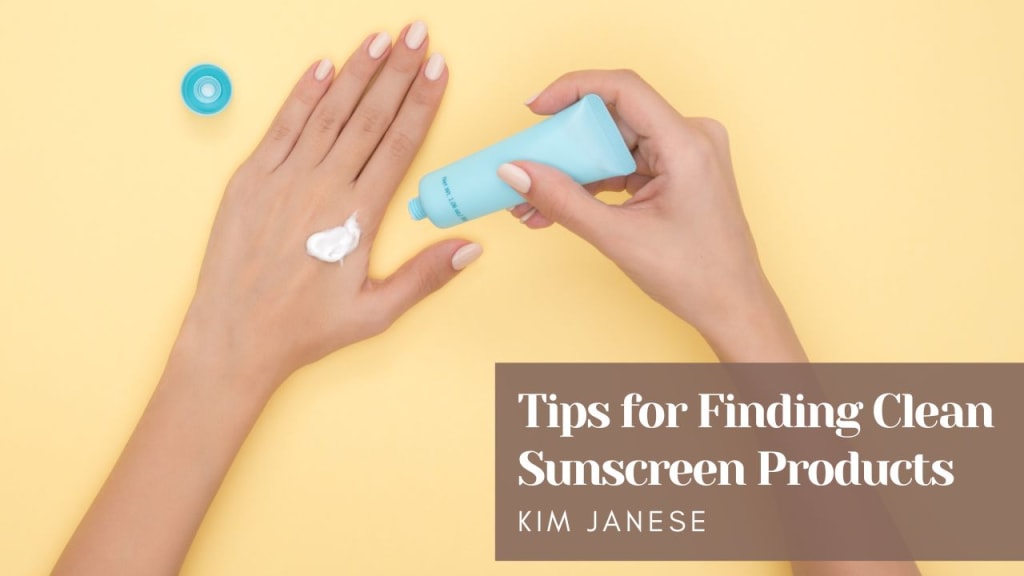Kim Janese on Tips for Finding Clean Sunscreen Products
Kim Janese discusses sunscreen

In addition to providing protection against UV radiation, sunscreen is fundamental for avoiding skin cancer and early aging. But it can be difficult to tell the difference between sunscreens that are actually safe and clean and those that are loaded with potentially dangerous ingredients in a sea of options. The lack of harmful components, the use of physical UV filters rather than chemical ones, and the low environmental effect are characteristics of clean sunscreens. They are crucial for those who want to lessen their chemical exposure while preserving the marine environments that sunscreen discharge damages.
A shift toward safer, more hygienic sunscreen formulations has been sparked by growing awareness of the harmful effects some sunscreen ingredients have on both the environment and human health. Conventional chemical sunscreens are thought to interfere with human hormone function because they absorb UV rays through chemical filters that have been connected to coral bleaching. As a result, the market is moving more toward physical mineral sunscreens, which physically block UV rays using titanium dioxide or zinc oxide.
Unlike their chemical equivalents, physical sunscreens give broad-spectrum protection without entering the skin, making them safe for both people and marine life. The clean sunscreen movement also places a strong emphasis on sustainable ingredient sourcing and environmentally friendly packaging, which reflects a larger commitment to environmental health. Customers have the difficult task of sorting through the confusing array of sunscreen creams, reading labels, and figuring out which ones really adhere to the clean beauty ideals.
Comprehending Ingredients
It's critical to comprehend and carefully review the ingredients list when choosing a clean sunscreen. Safe sunscreens ought to be devoid of dangerous substances like oxybenzone, octocrylene, and avobenzone, as they pose a risk to human health and negatively impact marine ecosystems. Look for sunscreens with zinc or titanium dioxide as elements. These minerals efficiently provide broad-spectrum protection by bouncing UV rays off the skin, therefore lowering the risk of hormone disruption or skin irritation.
The inactive components should also be taken into account. Steer clear of products with artificial elements. They may cause allergic reactions and have dubious safety records. It's also important to pick sunscreens containing antioxidants such as vitamin E or green tea extract, which may give further skin protection against environmental harm. Customers will be more equipped to make safer, healthier decisions if they carefully read ingredient labels and comprehend the purpose and effects of each component. Navigating the constantly shifting landscape of sunscreen products requires being aware of current research and recommendations from credible health and environmental organizations, even though the list of safe ingredients may change.
Acknowledging Certifications
When looking for clean sunscreen products, customers may get trustworthy guidance from certifications. Sunscreens that bear labels like "Reef-Safe," "EcoCert," and "Cruelty-Free" are guaranteed to adhere to strict environmental and moral guidelines. "Reef-Safe" accreditation, for instance, signifies that the product is free from substances known to cause coral bleaching, making it a safer option for ocean health. However, it's crucial to remember that the requirements for this distinction might vary; therefore, examining the certifying organization's standards is necessary.
"EcoCert" is a brand that specializes in the ecological and organic certification of personal care products. It guarantees that these products are made using ecologically friendly techniques and include a substantial amount of natural and organic components. The accreditation of "Cruelty-Free" indicates that the product and its contents have not undergone animal testing in accordance with ethical principles. While these certifications are helpful indicators, they should not be the sole criterion for selection. Customers are urged to examine corporate policies and the whole component list in addition to certificates. Comprehending the significance of each certification and merging this understanding with an exhaustive analysis of ingredients can result in more knowledgeable, responsible selections of sunscreen.
Impact on the Environment
In the search for clean options, the environmental impact of sunscreen products is just as important as personal health concerns. Sunscreens may damage marine life, especially coral reefs, which are crucial to ocean ecosystems. Clean sunscreens attempt to reduce this effect via both their ingredients and packaging. Choosing sunscreens with biodegradable formulas and eco-friendly packaging—such as recyclable or compostable materials—contributes to reducing the environmental footprint of sunscreen use. Positive environmental results may also be increased by endorsing businesses that put sustainability first in their sourcing and production procedures. For example, sunscreens containing titanium dioxide or non-nano zinc oxide are thought to be safer for marine life because coral is less likely to consume them.
Sifting through sunscreen options is more complicated than just picking one that is "natural" or "organic." It requires a careful examination of ingredients, an understanding of environmental certifications, and a consideration of the product's overall impact on both human health and the environment. Customers can protect their skin without sacrificing their moral or environmental principles by giving priority to sunscreens that contain safe, physical UV blockers like titanium dioxide and zinc oxide and avoiding those that contain hazardous chemicals. Recognizing and seeking out certifications may also steer customers toward items that correspond with their dedication to sustainability and cruelty-free practices.
Taking into account the environmental impact of sunscreen—from its components to its packaging—highlights the significance of responsible consumption. As awareness rises and the market for clean sunscreens expands, the collective choices of educated customers may push the industry toward more transparency, sustainability, and safety. In the end, the search for safe sunscreen is a continuous process that reflects a larger trend towards ecologically conscious, health-conscious living. People can improve their health, the health of the planet, and the future of sun protection by adopting these principles.
About the Creator
Kim Janese
Currently living in San Diego, CA, Kim Janese is a talented individual who lives life to the fullest. She loves traveling, connecting with people, and investing in personal development. http://kimjanese.org/
Enjoyed the story? Support the Creator.
Subscribe for free to receive all their stories in your feed. You could also pledge your support or give them a one-off tip, letting them know you appreciate their work.






Comments (1)
I'm enjoying this article for its excellent writing and informative content.